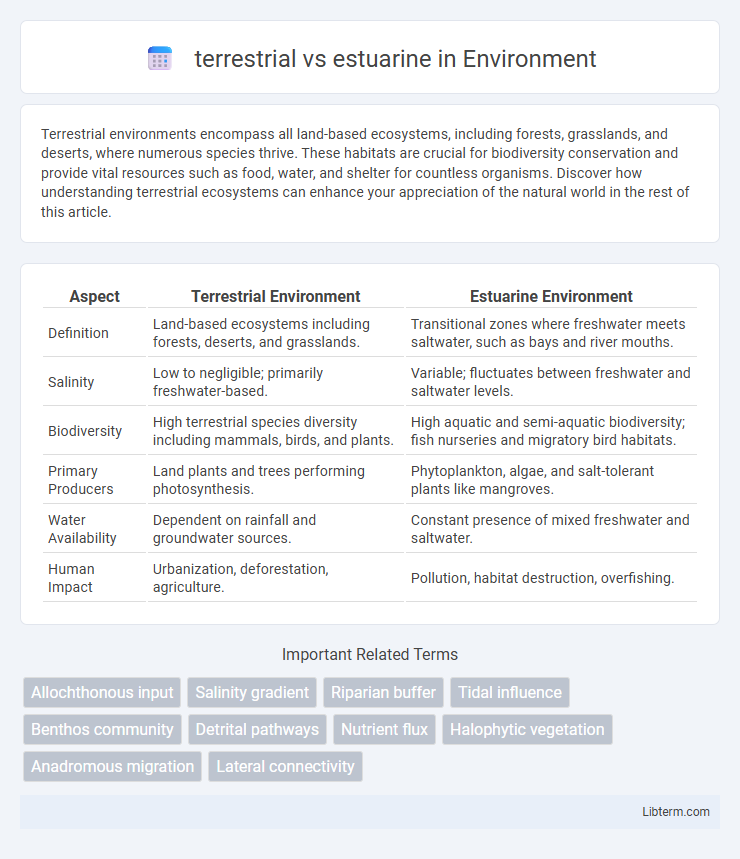Terrestrial environments encompass all land-based ecosystems, including forests, grasslands, and deserts, where numerous species thrive. These habitats are crucial for biodiversity conservation and provide vital resources such as food, water, and shelter for countless organisms. Discover how understanding terrestrial ecosystems can enhance your appreciation of the natural world in the rest of this article.
Table of Comparison
| Aspect | Terrestrial Environment | Estuarine Environment |
|---|---|---|
| Definition | Land-based ecosystems including forests, deserts, and grasslands. | Transitional zones where freshwater meets saltwater, such as bays and river mouths. |
| Salinity | Low to negligible; primarily freshwater-based. | Variable; fluctuates between freshwater and saltwater levels. |
| Biodiversity | High terrestrial species diversity including mammals, birds, and plants. | High aquatic and semi-aquatic biodiversity; fish nurseries and migratory bird habitats. |
| Primary Producers | Land plants and trees performing photosynthesis. | Phytoplankton, algae, and salt-tolerant plants like mangroves. |
| Water Availability | Dependent on rainfall and groundwater sources. | Constant presence of mixed freshwater and saltwater. |
| Human Impact | Urbanization, deforestation, agriculture. | Pollution, habitat destruction, overfishing. |
Introduction to Terrestrial and Estuarine Ecosystems
Terrestrial ecosystems are land-based environments characterized by diverse vegetation types such as forests, grasslands, and deserts, each supporting a variety of wildlife adapted to specific climatic and soil conditions. Estuarine ecosystems, found where freshwater rivers meet the ocean, exhibit unique brackish water habitats that support rich biodiversity, including numerous fish, bird, and plant species adapted to fluctuating salinity levels. These ecosystems play critical roles in nutrient cycling, habitat provision, and serve as buffers against coastal erosion and flooding.
Key Differences Between Terrestrial and Estuarine Habitats
Terrestrial habitats are characterized by land-based ecosystems with predominant vegetation such as forests, grasslands, and deserts, supporting diverse animal species adapted to stable, oxygen-rich environments. Estuarine habitats exist at the interface of freshwater and marine systems, featuring brackish water with fluctuating salinity levels that create unique conditions for specialized flora like mangroves and fauna including estuarine fish and shellfish. Key differences involve salinity gradients, species adaptations to water and soil conditions, and ecological processes influencing nutrient cycling and biodiversity.
Physical Characteristics of Terrestrial Environments
Terrestrial environments are characterized by solid ground with varying soil types, topography, and climate conditions, in contrast to estuarine environments which are transitional zones between rivers and marine waters. These land-based ecosystems exhibit diverse physical features such as mountains, plains, and deserts, influencing water availability, temperature fluctuations, and vegetation types. Terrestrial habitats support a wide range of flora and fauna adapted to dry or moist conditions, often experiencing greater temperature variability compared to estuaries.
Physical Features of Estuarine Ecosystems
Estuarine ecosystems are characterized by a unique blend of saline ocean water and freshwater from terrestrial sources, creating brackish water environments with variable salinity levels. These areas often feature tidal fluctuations, mudflats, salt marshes, and mangroves, providing complex habitats that differ significantly from terrestrial ecosystems, which are primarily dominated by soil-based substrates and stable freshwater conditions. Estuaries serve as critical transitional zones with nutrient-rich sediments, supporting diverse aquatic species and acting as natural buffers against coastal erosion and flooding.
Biodiversity in Terrestrial vs Estuarine Areas
Terrestrial ecosystems support diverse flora and fauna adapted to stable land environments, hosting complex food webs and varied habitats such as forests, grasslands, and deserts. Estuarine areas, where freshwater meets saltwater, exhibit high biodiversity due to nutrient-rich waters that sustain abundant species of fish, birds, and invertebrates critical for breeding and feeding. While terrestrial biodiversity includes large mammals and terrestrial plants, estuarine biodiversity is characterized by unique estuarine species and vital ecological functions like nursery grounds for marine life.
Adaptations of Flora and Fauna
Terrestrial flora often develop deep root systems and waxy leaves to conserve water, while estuarine plants such as mangroves exhibit salt tolerance and specialized pneumatophores for oxygen absorption in waterlogged soils. Fauna in terrestrial environments adapt through behaviors like burrowing and nocturnal activity to regulate temperature, whereas estuarine species display adaptations such as osmoregulation to cope with fluctuating salinity and specialized limbs for navigating muddy substrates. These distinct adaptations enable survival and reproductive success within their respective habitats' unique environmental stresses.
Ecological Roles and Functions
Terrestrial ecosystems regulate atmospheric gases through photosynthesis and carbon sequestration, supporting biodiversity and nutrient cycling in soil habitats. Estuarine ecosystems serve as critical nurseries for marine species, filter pollutants via sediment trapping, and moderate coastal flooding by absorbing storm surges. Both systems provide essential ecological services that sustain food webs and maintain environmental stability.
Human Impacts and Threats
Terrestrial ecosystems face threats primarily from deforestation, urbanization, and agriculture, leading to habitat loss and fragmentation that severely reduce biodiversity. Estuarine environments are highly vulnerable to pollution, nutrient loading from agricultural runoff, and coastal development, causing eutrophication and habitat degradation. Both ecosystems suffer from climate change effects, including altered hydrological cycles and increased frequency of extreme weather events, exacerbating stress on species and ecological functions.
Conservation Strategies for Both Ecosystems
Conservation strategies for terrestrial ecosystems emphasize habitat restoration, protected area establishment, and invasive species control to maintain biodiversity and ecosystem services. In estuarine ecosystems, conservation efforts prioritize water quality improvement, sustainable fisheries management, and the protection of critical habitats like mangroves and salt marshes to support aquatic biodiversity and enhance resilience to climate change. Integrating ecosystem-based management approaches ensures both terrestrial and estuarine environments are preserved to sustain ecological functions and support human livelihoods.
Conclusion: Importance of Terrestrial and Estuarine Balance
Maintaining a balance between terrestrial and estuarine ecosystems is crucial for biodiversity conservation and environmental stability. Terrestrial habitats provide essential nutrients and freshwater inputs that sustain estuarine productivity, while estuaries serve as critical nurseries for many aquatic species linked to land-based food webs. Disruptions in either system can lead to significant ecological imbalances, emphasizing the need for integrated management strategies to protect both environments.
terrestrial Infographic

 libterm.com
libterm.com